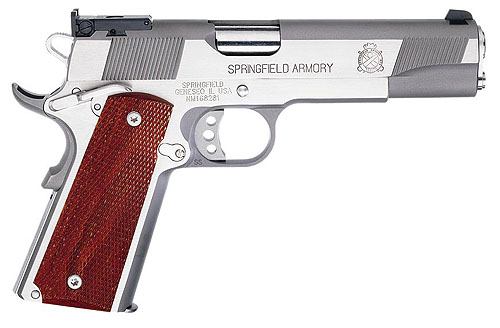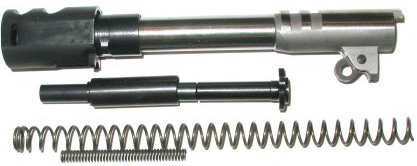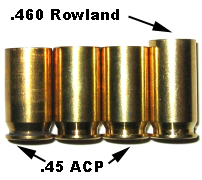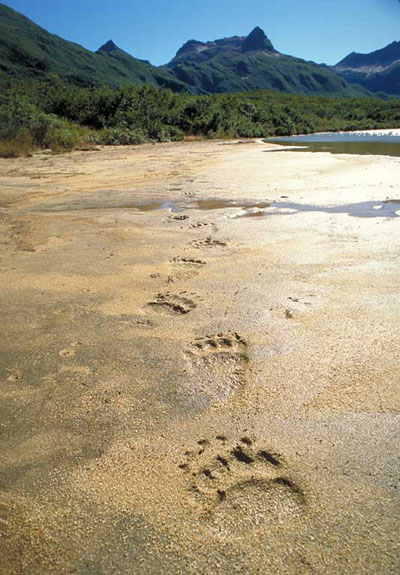A VERSATILE 1911-A1 PISTOL FOR ALASKA
By Warren Eastland
In southeast Alaska, where I live and play, there are bears. Just as folk from more settled places grow inured to the dangers of traffic, I’d grown used to the dangers posed by bears, perhaps a little too used to them. My wife, a.k.a. the Little Red Haired Girl, had been urging me to be a little less casual about them, but I hadn’t listened closely until the events described in “Jethro Comes Calling.” That incident got my attention: I’d had a rifle and three companions during that encounter, but I recalled many other times (too many) when I’d beached my boat and gone for a stroll with nothing more for defense than a pocket knife. That had to change; I’d have to start carrying a firearm.
A pistol isn’t the best way to fend off a large coastal brown bear, but it beats a Swiss Army Knife. Anything more adequate, such as a rifle, or at least a shotgun loaded with slugs, wasn’t really suitable: stowage space aboard a boat is limited, and I knew I’d not bother dragging out a long gun from wherever I’d manage to stow it just for a short trip ashore—even though I also knew that’s when I’d likely need one the most.
There are myriad options for a pistol, but the Little Red Haired Girl’s needs had to be considered as well as mine. She had to be able to use it, too. I had a usable .357 Magnum, but it had two strikes against it. First, it's blued, and would rust fairly easily in the saltwater environment. Second, it's a revolver. The LRHG has an autoloading .22 pistol with which she is both familiar and a good shot, one loosely based on John Browning’s designs of the early 1900s. She had never used a revolver and, frankly, wasn’t much interested in doing so, especially after firing the .357 a couple of times.
While the objectionable recoil was something she’d ignore in a dust-up with a bear, it bothered her to the point where she wouldn’t practice with the .357. I needed to find a semi-auto with tolerable recoil so that she would practice, and it needed enough power to dissuade a bear at very close range. Not being a real pistolero, the first thing that came to my mind was a 1911-A1. This design is very similar to her .22, so she’d be familiar with its operation and function, but the .45 ACP caliber really doesn’t have the power to deal with a bear.
I discussed my problem with a friend and his suggestion was to go ahead and get the .45 and add to it. Using a single frame, the pistol could be a .22, a .45ACP, or a .460 Rowland, among other things; I was limited only by the overall length and diameter of the cartridge.
“Pardon my French,” I asked my gun-buddy, “but just what the hell is a .460 Rowan?”
 “That’s Rowland. It's a new cartridge, one that takes advantage of the new powders. It's based on the .45 ACP case, but lengthened a bit so that it won’t chamber in a garden-variety .45. The bullet is also seated a bit deeper so that it’ll function in a 1911. All you have to do is change the barrel, and your 1911-A1 is a .460 Rowland. You get .44 Magnum performance that way, in an autoloader. The sweet kicker is that with a heavy recoil spring and a compensator, it doesn’t recoil much more than a .45 ACP. The LRHG can handle it just fine.”
“That’s Rowland. It's a new cartridge, one that takes advantage of the new powders. It's based on the .45 ACP case, but lengthened a bit so that it won’t chamber in a garden-variety .45. The bullet is also seated a bit deeper so that it’ll function in a 1911. All you have to do is change the barrel, and your 1911-A1 is a .460 Rowland. You get .44 Magnum performance that way, in an autoloader. The sweet kicker is that with a heavy recoil spring and a compensator, it doesn’t recoil much more than a .45 ACP. The LRHG can handle it just fine.”
After a bit of horse-trading that opened up some closet space, and the expenditure of a little cash, I was the owner of a new full-sized (5” barrel) stainless steel Springfield Armory 1911-A1 in caliber ".45 Automatic Colt’s Pistol," plus the spare pieces that would turn it into either a .22 Long Rifle, or a .460 Rowland.
The .22 conversion kit is from Marvel’s (www.marvelprecision.com) and consists of a replacement slide of machined aluminum with hardened steel inserts at the bolt face and adjustable sights, a barrel, recoil spring and  guide, and a replacement assembly pin. The conversion changes the action of the pistol from the camming, drop-barrel action of John Browning’s 1911 design to that of a blowback pistol, such as he used in his earlier models of auto loaders.
guide, and a replacement assembly pin. The conversion changes the action of the pistol from the camming, drop-barrel action of John Browning’s 1911 design to that of a blowback pistol, such as he used in his earlier models of auto loaders.
The slide doesn’t lock back after the last round is fired, hence the replacement pin that would ordinarily be the slide catch. The nine pound recoil spring is stiff enough to reliably strip cartridges from the 10-round magazine. A piece of paper that came with the assembly specifically states that the conversion won’t work with Federal ammo: they’re right. With Federal ammunition it fires most times, but fails to strip a new round, or stovepipes, and just fails to function properly. The unit is designed to work with high velocity, not standard velocity, .22LR ammo. When the unit is brand new, count on it functioning intermittently: until the parts are worn in a bit, it doesn’t seem to matter what ammunition it is fed; it just goofs up occasionally. After a box or two of decent high velocity ammo, though, it works as advertised. And it is accurate.
My first use of it was off the back of my boat. The LRHG and I set the anchor one evening in one of innumerable secluded coves among the islands and peninsulas of southeast
I smiled and pulled out a pack of balloons. I handed her one, then took one for myself and proceeded to blow it up. She followed suit. When we had the cabin (it’s a small one) filled with six-to-eight-inch-diameter balloons, we stepped out onto Kapenta's stern and loaded our magazines with regular Remington high velocity ammunition. I stood behind her and tossed a balloon over her shoulder. It landed on the water and the breeze scuttled it from side to side as the wavelets bobbed it up and down. “Fire away,” I said. When that one popped, I tossed another over. When the slide on her .22 semi-auto locked open, she stepped back and I moved up.
I was at a disadvantage because the balloon had already begun its escape run. I had to hand-cycle the slide a few times, but I popped the balloon some 30 yards out. We swapped places and continued. Of the 25 balloons in the pack, only two escaped whole. The farthest shot I made was something on the order of 70 yards, one that would have been impossible but for the bullet dimples on the water’s surface to guide me.
By the time we’d worked through three boxes of ammo, the 1911 with the Marvel conversion kit was functioning far more often than not. A subsequent trip to the range finished the break-in period, and it now works consistently, delivering two-inch groups at 25 yards. That isn’t outstanding accuracy and I’m not sure if it is the pistol or just that my old eyes don’t handle open sights as well as they did a few decades ago. I console myself with the thought that the group is smaller than a rabbit’s head.
 The conversion kit to .460 Rowland is made by Clark and consists of a replacement barrel with attached recoil compensator and barrel bushing, a recoil spring with guide rod and spring cap, and a slide catch pin that seems to be
The conversion kit to .460 Rowland is made by Clark and consists of a replacement barrel with attached recoil compensator and barrel bushing, a recoil spring with guide rod and spring cap, and a slide catch pin that seems to be  identical to the original one on the pistol. Despite the caliber name, the ".460" Rowland is in fact a .45 caliber round. The case is about 1/16 of an inch longer than that of standard .45ACP and the brass is a bit thicker to handle the increased pressures, but the bullet is seated a bit deeper so that the overall cartridge length is the same as for the ACP.
identical to the original one on the pistol. Despite the caliber name, the ".460" Rowland is in fact a .45 caliber round. The case is about 1/16 of an inch longer than that of standard .45ACP and the brass is a bit thicker to handle the increased pressures, but the bullet is seated a bit deeper so that the overall cartridge length is the same as for the ACP.
 A straight-walled autoloading pistol case headspaces on its mouth against a step in the chamber. The Rowland round is deliberately made longer so that it won't chamber in a standard ACP barrel. I haven’t tried the conversion kit on other 1911 frames, but on the
A straight-walled autoloading pistol case headspaces on its mouth against a step in the chamber. The Rowland round is deliberately made longer so that it won't chamber in a standard ACP barrel. I haven’t tried the conversion kit on other 1911 frames, but on the
.460 Rowland Ammunition is commercially available from Georgia Arms, and perhaps others, but it isn’t carried in any of the local shooting emporia, so I had to use reloads. I didn't do my own research on the .460 Rowland round (for the first, and the last, time). My gunbuddy is a long time reloader and shooter and is generally more knowledgeable than I, so when he handed me a box of Rowland reloads, I just assumed that they were loaded properly.
I sat at my dining room table and struggled with getting the conversion barrel onto my pistol. Everything fit perfectly, but pressing in on a 24# spring while turning the barrel bushing took a few tries until I got everything right. After considerable practice, and using a piece of doweling to put the pressure on the recoil spring cap, I now can do it with no problem but the first time wasn't easy on my thumbs. Then I took the pistol and the box of ammo out to the range.
The recoil was considerably more than the standard .45 auto. My gunbuddy had told me that the recoil level was "similar to the .45ACP," but it sure didn’t seem that way to me. It had been a considerable time since I’d shot a large caliber handgun, though, so perhaps I was just a bit oversensitive. Besides, the Rowland is the ballistic equivalent of the .44 Magnum, and I know how much recoil they have.
I aimed at the cardboard
First, the recoil was a bit more than the LRHG was going to be happy with. I could work around that: I’d just have her practice with regular .45 ammo (after all, that was part of the rationale behind getting the pistol and the conversion kits in the first place). What had me more worried, though, was the apparent unreliability of the conversion. If it wouldn’t auto-load, I might as well have a single shot because a bear wasn’t going to wait around for me to hand-cycle the slide every time.
I finished the magazine and encountered more failures to feed. Disgusted, I picked up my brass from the cement floor then looked closely at it. The primer indentations had been blown back so that the surface of the primer was smooth! What was going on? I didn’t know what was wrong, but I did know that something was not copasetic. I took my gear back home and started to do what I should have done in the first place: I did my homework.
My gunbuddy is meticulous in his note keeping. His loads had
One way to assess just how sensitive a powder in a given load is, is to look at the range of loads. Using AA#7, the range was less than two full grains, and it peaked at 13 grains. I learned a lot from this experience. I will never, ever, never use anyone else’s reloads ever again. I also learned that the .460 Rowland conversion barrel in the 1911 will handle a lot more pressure than any reload that I will ever use.
I pulled all the bullets from the remainder of the loads and dumped the powder. I reloaded them with a proper load: then the pistol worked flawlessly, and the recoil wasn’t much different from that of the pistol with normal .45ACP loads. The malfunctioning was caused by the excessive loads.
However, I was still nervous about the very narrow range of loads when using AA#7 powder, so I started checking reloading data carefully. I finally settled on Hodgdon's Long Shot. The suggested range is equally as narrow, from 12.0 to 13.8 grains for the 200 grain bullet. By loading below the maximum level, I keep the pressures are a bit low so that there is a safety buffer if I somehow goof up. After testing several loads, I settled on 13.1 grains of Long Shot powder and a 200 grain bullet as my load. The velocity is up around 1400 fps which gives the round similar ballistics to the .44 Magnum and it functions flawlessly in my pistol.
 Although it might seem strange to most people, my last concern is accuracy. The load is accurate enough in my pistol to keep all the shots in a three-inch circle at 30 yards, but accuracy is still my last consideration. The purpose of the pistol is to deal with bears at close range after all my other options and attempts to avoid the situation have failed. In that case, the bear will be close and moving. I’ll be scared and pumped full of adrenaline so that pinpoint accuracy won’t be possible. After a lot of practice, from a ready position I can put nine rounds through a standard piece of paper at 15 feet in under two seconds; that’s an area the size of a brown bear’s head and the time is about four times slower than bear would cover the distance unchecked.
Although it might seem strange to most people, my last concern is accuracy. The load is accurate enough in my pistol to keep all the shots in a three-inch circle at 30 yards, but accuracy is still my last consideration. The purpose of the pistol is to deal with bears at close range after all my other options and attempts to avoid the situation have failed. In that case, the bear will be close and moving. I’ll be scared and pumped full of adrenaline so that pinpoint accuracy won’t be possible. After a lot of practice, from a ready position I can put nine rounds through a standard piece of paper at 15 feet in under two seconds; that’s an area the size of a brown bear’s head and the time is about four times slower than bear would cover the distance unchecked.
Under this kind of stressful fast shooting, the autoloader works for me better than a revolver. Without the cycling action of the slide and recoil spring in the 1911 to use up some of the recoil energy, the recoil of the revolver is too powerful for me to get the pistol back on the target quickly enough. Too, I have small hands and the heavy pull of a double action revolver tends to pull me off target. Finally, with eight rounds in the magazine (a Chip McCormick product) and one in the chamber, I’m starting out with three more rounds than a revolver will hold.
No pistol is truly adequate as a defensive weapon against coastal brown bears, but enough people have successfully defended themselves with one to show that they can work. Is the 1911-A1 a good choice? Probably not in .45ACP. The cartridge was never designed with that in mind, and the velocities are just too slow to ensure adequate penetration. Most successful defenses against
The versatility of this setup is one of its prime virtues. In a single frame with interchangeable tops, I’ve got a fine camp pistol: the .22 conversion lets me take rabbits, ptarmigan, and other small game for the pot. With the .460 Rowland barrel installed, I’ve got something to argue back with should a bear decide it wants to get in the tent with me. And with the standard .45ACP, I can kill big halibut before I gaff them and drag them on board.
| HUNTING | GUNS | DOGS |
| FISHING & BOATING | TRIP REPORTS | MISCELLANEOUS ESSAYS |
| CONTRIBUTIONS FROM OTHER WRITERS|
| RECIPES |POLITICS |
